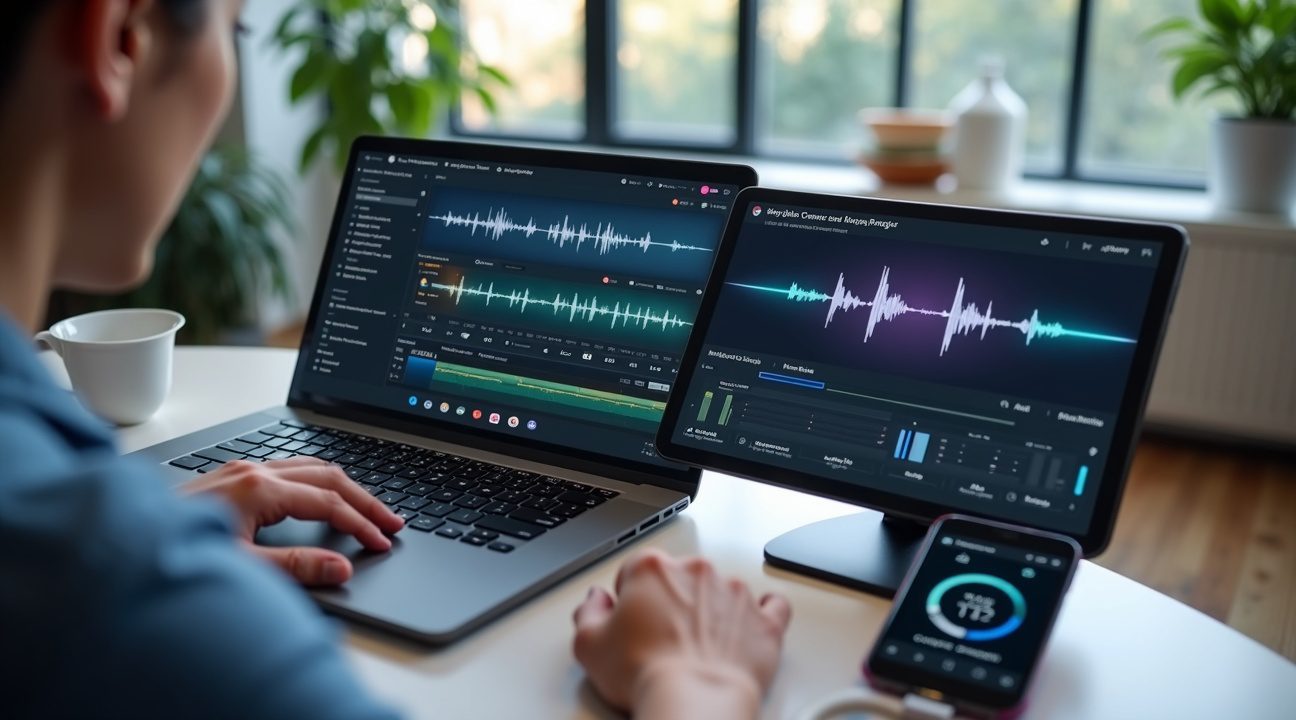The audio editing software market shows remarkable expansion, with projections reaching $1.20 billion by 2033. AI-powered features and mobile accessibility drive this growth, making professional-quality editing accessible for complete beginners. Modern applications provide intuitive interfaces, cloud-based collaboration, and automation tools that remove traditional technical barriers. Newcomers can now focus on creativity rather than complex workflows.
Key Takeaways
- Free options provide solid foundations – Audacity, Ocenaudio, and WavePad deliver comprehensive editing capabilities without financial commitment, creating ideal starting points for beginners.
- Cloud and mobile platforms revolutionize accessibility – Browser-based editors like MyEdit and mobile apps like Lexis Audio Editor enable professional editing without software installation or powerful hardware.
- AI automation simplifies complex tasks – Modern apps feature automatic noise removal, speech-to-text conversion, and one-click mastering that produce professional results without technical expertise.
- Collaborative features enhance learning – Real-time collaboration tools, shared workspaces, and cross-platform compatibility make audio editing more accessible for educational and team projects.
- Essential beginner features include intuitive interfaces – Drag-and-drop functionality, built-in tutorials, comprehensive format support, and active user communities accelerate the learning process.
Why the Audio Editing Market is Booming for New Users in 2025
I’m witnessing an incredible surge in the audio editing software market that’s creating unprecedented opportunities for beginners to jump into content creation. The global audio editing software market is projected to reach $1.20 billion by 2033 with a compound annual growth rate of 5.2% from 2025 to 2033. This explosive growth isn’t just numbers on a spreadsheet – it represents a fundamental shift in how accessible audio editing has become for everyday users.
Market Forces Driving Beginner Adoption
Several powerful trends are making audio editing more approachable than ever before. Software developers are prioritizing user-friendly interfaces that eliminate the steep learning curves that once intimidated newcomers. I’ve seen artificial intelligence and automation features transform complex editing tasks into simple, one-click operations that even complete beginners can master quickly.
Mobile and cloud-based solutions are revolutionizing accessibility, allowing users to edit audio directly from their smartphones or tablets without expensive desktop software. Remote collaborative workflows have gained massive traction, enabling beginners to learn from mentors and work with teams regardless of geographic location. These innovations mirror trends I’ve observed in other tech sectors, similar to how Twitter finally adds in edit button features that users have long demanded.
Geographic Growth and User Demographics
North America currently leads the market, followed by Europe and Asia Pacific, but Asia Pacific is expected to experience the fastest growth due to rising digital content creation and education in emerging economies. The combined audio and video editing software market will hit $3.65 billion in 2025 and rise to $4.98 billion by 2029 at a CAGR of 8.1%, demonstrating the interconnected nature of multimedia editing tools.
Musicians make up the largest user segment, but beginner demand is rising dramatically among:
- Podcasters
- Online creators
- Students
- Businesses
I’ve observed that podcasting has become particularly accessible, with many creators starting their audio journey using simple editing apps before advancing to professional software. Students are increasingly using audio editing for presentations and projects, while businesses are creating internal training materials and marketing content.
This market expansion creates a virtuous cycle where increased demand drives innovation in beginner-friendly features, which in turn attracts more new users. Software companies are responding with:
- Freemium models
- Extensive tutorial libraries
- Simplified interfaces
These developments make professional-quality audio editing achievable for anyone with a creative vision.
Top Free Audio Editing Apps That Make Learning Simple
I recommend starting with free audio editing software before investing in premium options. These applications provide excellent foundations for learning audio editing fundamentals without financial commitment.
Audacity: The Gold Standard for Beginners
Audacity stands as the most popular choice for first-time audio editors. This open-source application runs on Windows, macOS, and Linux, offering a straightforward interface that doesn’t overwhelm newcomers. I find its multi-track editing capabilities particularly valuable for beginners who want to layer recordings or combine multiple audio sources.
The software includes essential effects and supports plugin expansions as skills develop. What sets Audacity apart is its massive community of users who create countless tutorials. These resources make learning easier, whether someone needs to remove background noise or master basic audio compression techniques.
Streamlined Alternatives for Quick Learning
Ocenaudio offers a different approach with its real-time effect preview feature. This functionality allows users to hear changes instantly, making the learning process more intuitive. I appreciate how this application simplifies the editing experience compared to Audacity while maintaining professional-grade capabilities for handling large files and advanced selection tools.
WavePad provides exceptional versatility across platforms, running on Windows, macOS, iOS, and Android devices. Its batch processing feature saves significant time when working with multiple files. The application includes practical effects such as:
- Echo and reverb for creative enhancement
- Amplification tools for volume control
- Built-in equalizer for frequency adjustment
- Audio restoration features for cleaning recordings
- Direct voice recording capabilities
These tools cover most scenarios beginners encounter, from podcast editing to music production basics. WavePad’s cross-platform availability means users can edit audio on their phones during commutes or switch between desktop and mobile workflows seamlessly.
Each application remains free for personal and educational use, though premium versions unlock advanced features. I suggest starting with one application and mastering its core functions before exploring others. This focused approach builds confidence and prevents the confusion that comes from jumping between different interfaces. The learning curve becomes manageable when users concentrate on understanding fundamental concepts like cutting, copying, applying effects, and exporting files in various formats.
These free options provide everything needed to develop solid audio editing skills. Quality headphones enhance the editing experience by revealing audio details that standard speakers might miss.
Game-Changing Cloud and Mobile Editors for Modern Beginners
Modern audio editing has moved beyond traditional desktop software, giving beginners powerful alternatives that work directly in web browsers and on mobile devices. I’ve found these cloud-based and mobile-friendly options particularly valuable for newcomers who want professional results without the complexity of traditional software installation.
Top Browser and Mobile Options
Two standout platforms define this new generation of accessible editors:
- MyEdit operates entirely within web browsers, requiring no downloads or installation
- Lexis Audio Editor provides cross-platform mobile editing across Windows, Android, and iOS devices
- Both platforms offer free versions with optional premium upgrades for advanced features
- Real-time collaboration and cloud storage eliminate file transfer headaches
MyEdit stands out as a browser-based solution that transforms any device into a capable editing station. I appreciate how it handles files up to 300MB and 30 minutes without requiring software installation, making it perfect for audio enthusiasts using Chromebooks or shared computers. The platform includes AI-powered noise reduction, vocal removal capabilities, and automatic speech-to-text conversion that rivals desktop applications. Premium features cost just $4 monthly, providing exceptional value for occasional users.
Lexis Audio Editor takes a mobile-first approach that I find revolutionary for beginners who prefer working on phones and tablets. Recording, editing, and exporting happen directly on mobile devices, complete with real-time effects and built-in noise reduction. Voice-activated recording eliminates the need for manual controls, while individual premium features cost $9.99 each, allowing users to purchase only what they need.
Cloud-based platforms deliver several advantages that traditional software can’t match:
- Automatic updates ensure users always access the latest features without manual downloads
- Device independence means projects remain accessible from any internet-connected device
- Easy sharing capabilities streamline collaboration for classroom projects and team initiatives
These modern solutions particularly benefit beginners who feel overwhelmed by traditional software complexity. Browser-based editors eliminate installation concerns, while mobile applications let users edit audio content anywhere inspiration strikes. The simplified interfaces focus on essential editing tasks without intimidating professional features that novices rarely use initially.

Essential Features Every Beginner Should Look For
I always recommend starting with apps that prioritize user-friendly design elements. An intuitive interface with drag-and-drop functionality makes audio editing feel less overwhelming for newcomers. Easy navigation reduces the learning curve significantly, allowing beginners to focus on creativity rather than struggling with complex menu systems.
Learning Support and Community Resources
Built-in tutorials serve as invaluable guides during those first editing sessions. I’ve found that active user communities provide ongoing support when questions arise beyond basic tutorials. Forums and help sections within apps often contain solutions to common beginner challenges, making the transition smoother for new users.
Core Editing Functions
Essential editing capabilities form the foundation of any solid audio editing experience. Key functions include:
- Trimming and splitting audio clips for precise control
- Noise reduction tools to clean up recordings
- Equalization options for sound balance adjustments
- Pitch and speed adjustment features for creative flexibility
- Export capabilities to common formats like MP3, WAV, and FLAC
These core functions handle most basic editing needs without overwhelming beginners with advanced features they don’t yet require.
AI-powered tools represent a game-changing addition for novice editors. Auto-denoise features automatically clean up background noise without manual intervention. Speech enhancement tools improve vocal clarity with minimal user input. BPM detection assists with music projects by automatically identifying tempo. Text-to-speech functionality opens creative possibilities for podcast intros or voiceovers.
I’ve noticed that modern audio editing apps increasingly integrate these intelligent features, making professional-quality results achievable even for complete beginners. The automation reduces technical barriers while teaching fundamental concepts through practical application.
Format compatibility ensures projects remain accessible across different devices and platforms. Apps supporting multiple export options provide flexibility for various use cases, whether creating podcasts, music tracks, or simple voice recordings.
User interface design directly impacts learning speed and enjoyment. Clean layouts with clearly labeled tools help beginners locate necessary functions quickly. Quality audio equipment pairs well with user-friendly software to create an optimal editing environment.
Real-time preview capabilities allow immediate feedback during editing sessions. This instant visual and auditory response helps beginners understand how changes affect their audio files, accelerating the learning process through immediate cause-and-effect relationships.
Cloud integration features enable seamless project management across multiple devices. Automatic saving prevents work loss during those inevitable learning moments when mistakes happen. Version control helps track changes and revert to previous states when experiments don’t produce desired results.
Performance optimization ensures smooth operation even on modest hardware configurations. Efficient resource usage prevents frustrating delays that can discourage continued learning efforts.
How AI and Automation Are Revolutionizing Audio Editing for Newcomers
I’ve witnessed a dramatic shift in how beginners approach audio editing, thanks to artificial intelligence and automation features that have transformed what was once a complex craft into an accessible creative outlet. Modern audio editing applications now harness machine learning algorithms to eliminate the technical barriers that traditionally intimidated newcomers.
AI-Powered Features That Simplify Complex Tasks
Today’s apps deliver sophisticated capabilities through intuitive interfaces that require minimal technical knowledge. AI-based noise removal tools can instantly clean up recordings without requiring users to understand frequency analysis or manual filter adjustments. Auto-mixing features analyze audio tracks and apply appropriate levels, EQ, and effects automatically, producing professional-sounding results that would have taken hours to achieve manually.
Speech-to-text functionality represents another breakthrough for beginners. These tools transcribe audio content automatically, making it easier to edit podcasts, interviews, or voiceovers by working with text rather than waveforms. MyEdit exemplifies this approach by offering AI-powered noise removal, vocal extraction capabilities, and automatic caption generation, with 3 credits per day included in their free plan.
Machine learning integration continues to expand across audio editing platforms, with algorithms learning from user behavior to suggest edits, detect issues, and streamline workflows. Background noise detection happens automatically, while AI can identify and separate different audio elements like music, speech, and sound effects without manual intervention.
Mobile Revolution and Accessibility
Smartphones and tablets have become legitimate audio editing platforms, putting professional-grade tools in everyone’s pocket. Mobile apps now handle tasks that once required desktop software, from quick podcast edits to complete music production. Recording voiceovers on the go has become seamless, with apps automatically adjusting levels and applying real-time effects during capture.
The convenience factor can’t be overstated for beginners who want to experiment without committing to expensive software or complex workflows. Many discover their passion for audio editing through mobile apps before graduating to more advanced desktop solutions. Gaming headset technology has also improved dramatically, providing budget-friendly monitoring options for mobile creators.
Cloud-based processing enables mobile apps to perform computationally intensive tasks like AI noise removal and auto-mastering without draining device batteries or requiring powerful hardware. This democratization of audio editing tools means beginners can produce professional-quality content regardless of their budget or technical expertise.
I recommend starting with apps that emphasize automation while still allowing manual control when desired. This approach lets beginners achieve immediate results while gradually learning more advanced techniques. Features like:
- One-click mastering
- Automatic level adjustment
provide safety nets that prevent common mistakes while users develop their skills.
The integration of AI in audio editing continues accelerating, with new features regularly added to existing apps. Voice cloning, automatic music generation, and advanced noise suppression capabilities that once required specialized knowledge are now available through simple button clicks. This trend makes audio editing more approachable than ever for creative individuals who want to focus on content rather than technical details.
https://www.youtube.com/watch?v=bLvK-szBJ2U
The Future of Collaborative and Cross-Platform Audio Editing
Audio editing has transformed from a solo endeavor into a dynamic, collaborative experience that breaks down traditional barriers. I’ve watched this evolution firsthand, and the shift toward team-based audio production is reshaping how beginners approach their first projects.
Real-Time Collaboration Features
Modern audio editing platforms now support multiple users working on the same project simultaneously. These collaborative features prove especially valuable for educational environments where instructors can provide live feedback during audio editing sessions. Group podcasting projects, band recordings, and multimedia presentations benefit enormously from this shared workspace approach.
Key collaborative capabilities include:
- Live commenting systems that let team members leave timestamped feedback
- Version control that tracks changes and prevents conflicting edits
- Permission settings that allow project owners to control editing access
- Real-time chat integration for instant communication during sessions
- Shared asset libraries where teams can access common sound effects and music
Cloud-based audio editing platforms have experienced remarkable growth as they eliminate the need for expensive local software installations. Beginners can access professional-grade tools through any web browser, making high-quality audio editing available regardless of their device’s processing power. This democratization of audio technology has opened doors for creators who previously couldn’t afford professional software or powerful hardware.
Device independence represents perhaps the most significant advantage for newcomers to audio editing. I can start a project on my laptop during lunch break, continue editing on my tablet while commuting, and add final touches using my smartphone before publication. This flexibility accommodates different learning styles and schedules, particularly benefiting students and hobbyists who don’t have dedicated studio time.
Cross-platform compatibility ensures that project files remain accessible across operating systems. Whether someone uses Windows, Mac, iOS, or Android, they can contribute to shared projects without compatibility concerns. Auto-sync features keep work updated across all devices, preventing the frustration of lost progress or outdated versions.
Remote work has accelerated adoption of these collaborative tools, with many creators discovering that distributed teams can produce content more efficiently than traditional in-person sessions. Technology companies continue investing heavily in improving these collaborative experiences, promising even more seamless integration between different platforms and devices.
The accessibility improvements extend beyond convenience into genuine inclusivity. Beginners with limited budgets or older devices can now participate in professional-quality audio projects. Cloud processing handles computationally intensive tasks, while intuitive interfaces guide users through complex editing procedures that once required years of training to master.
https://www.youtube.com/watch?v=XRz_NL9hP3EjOM
Sources:


